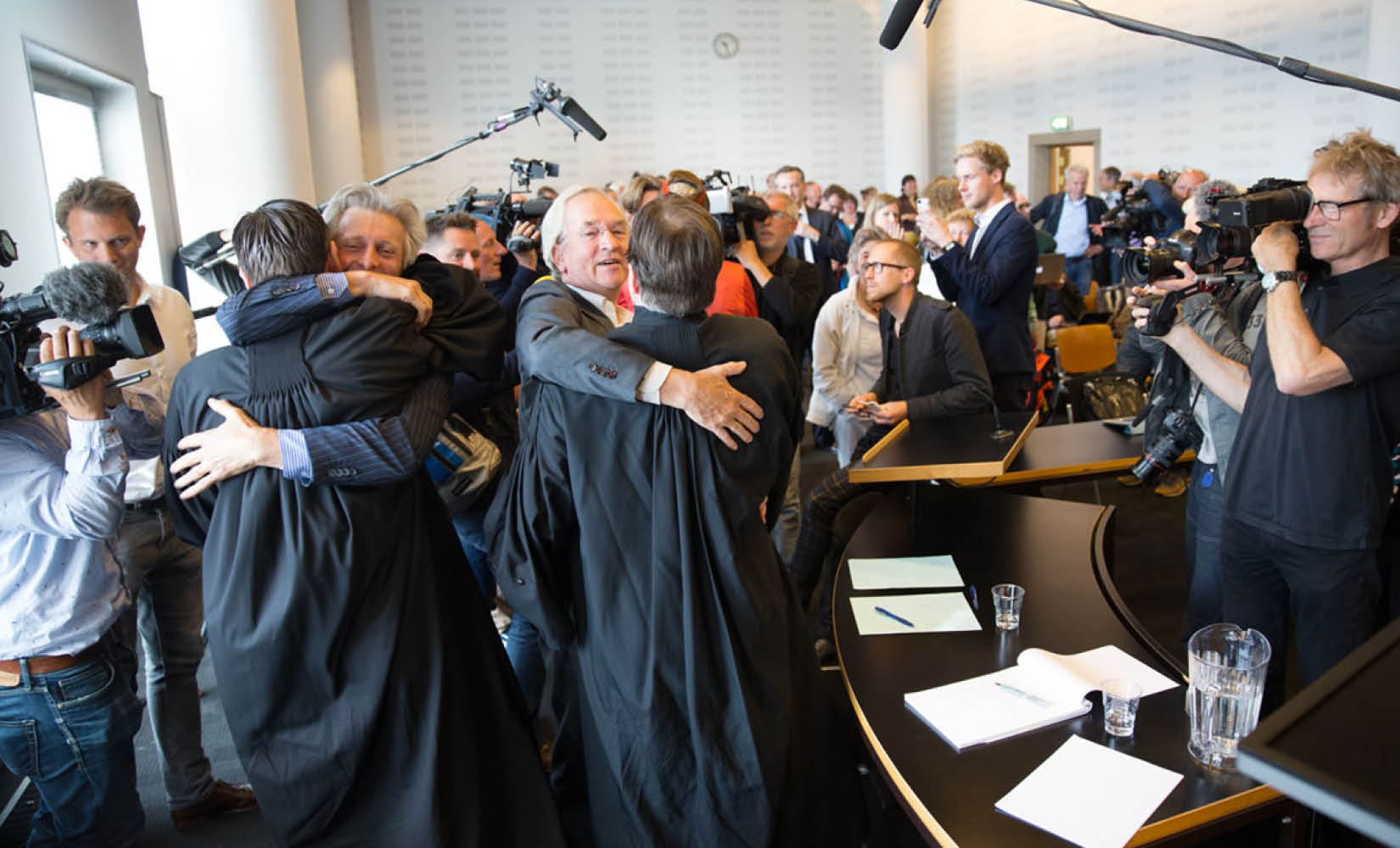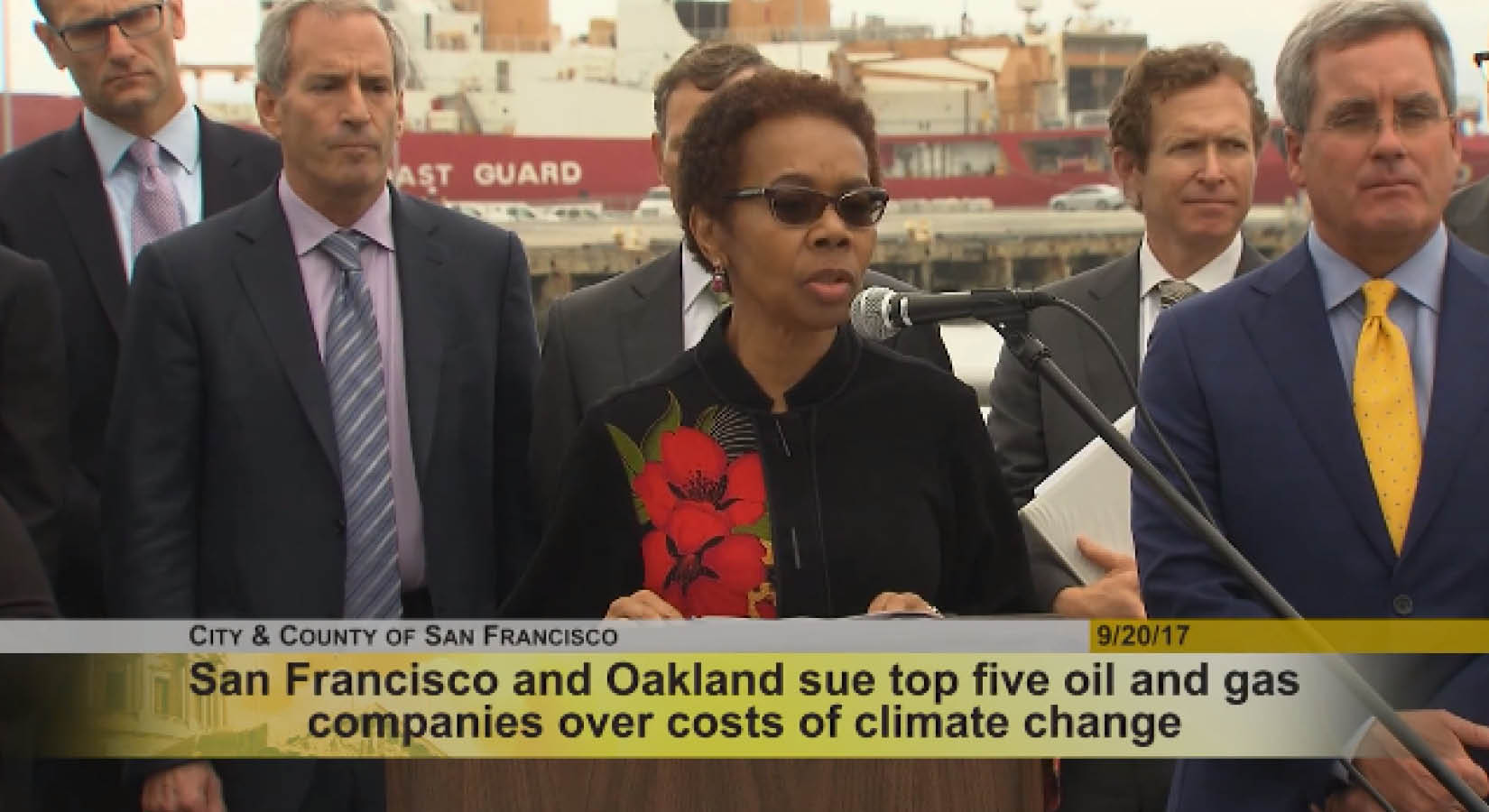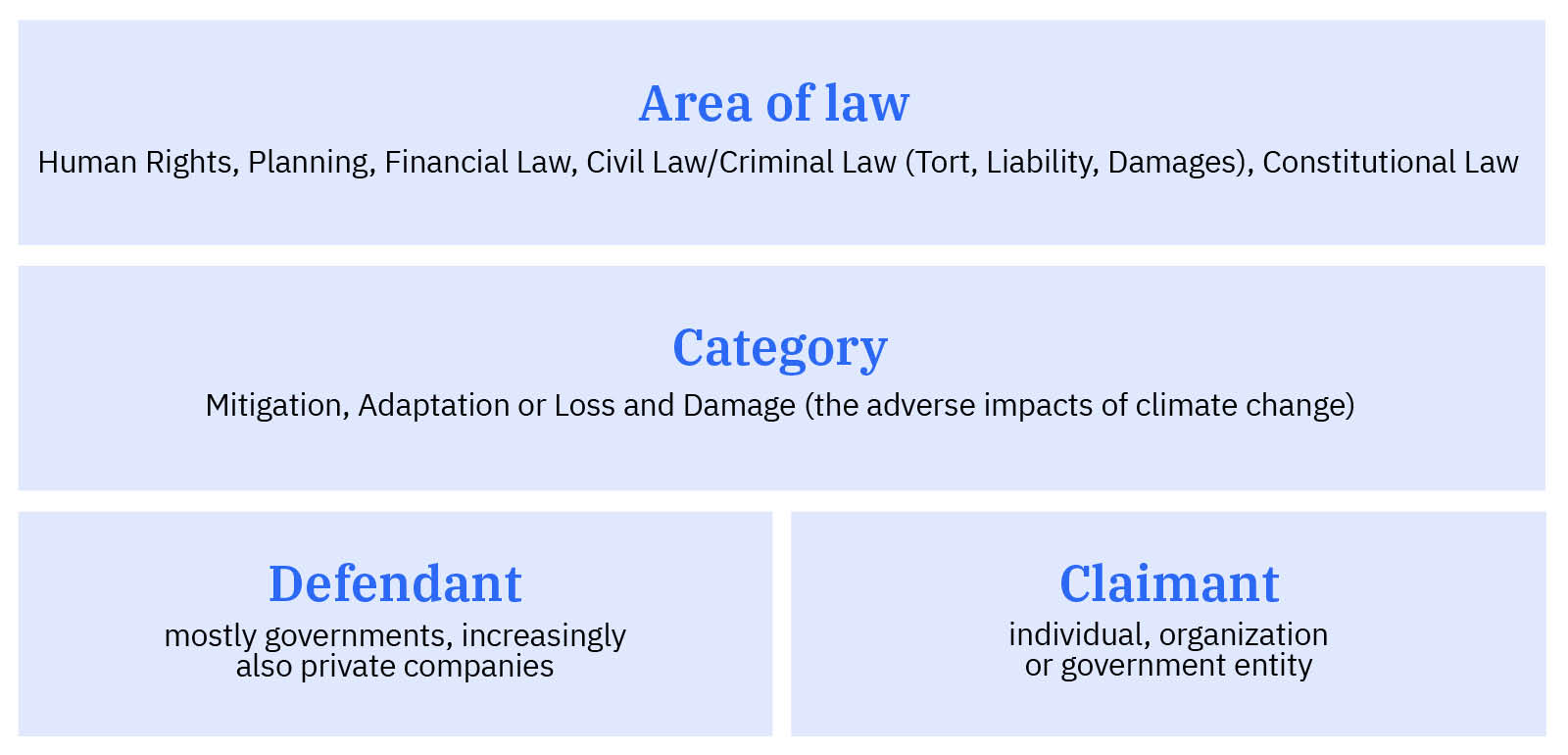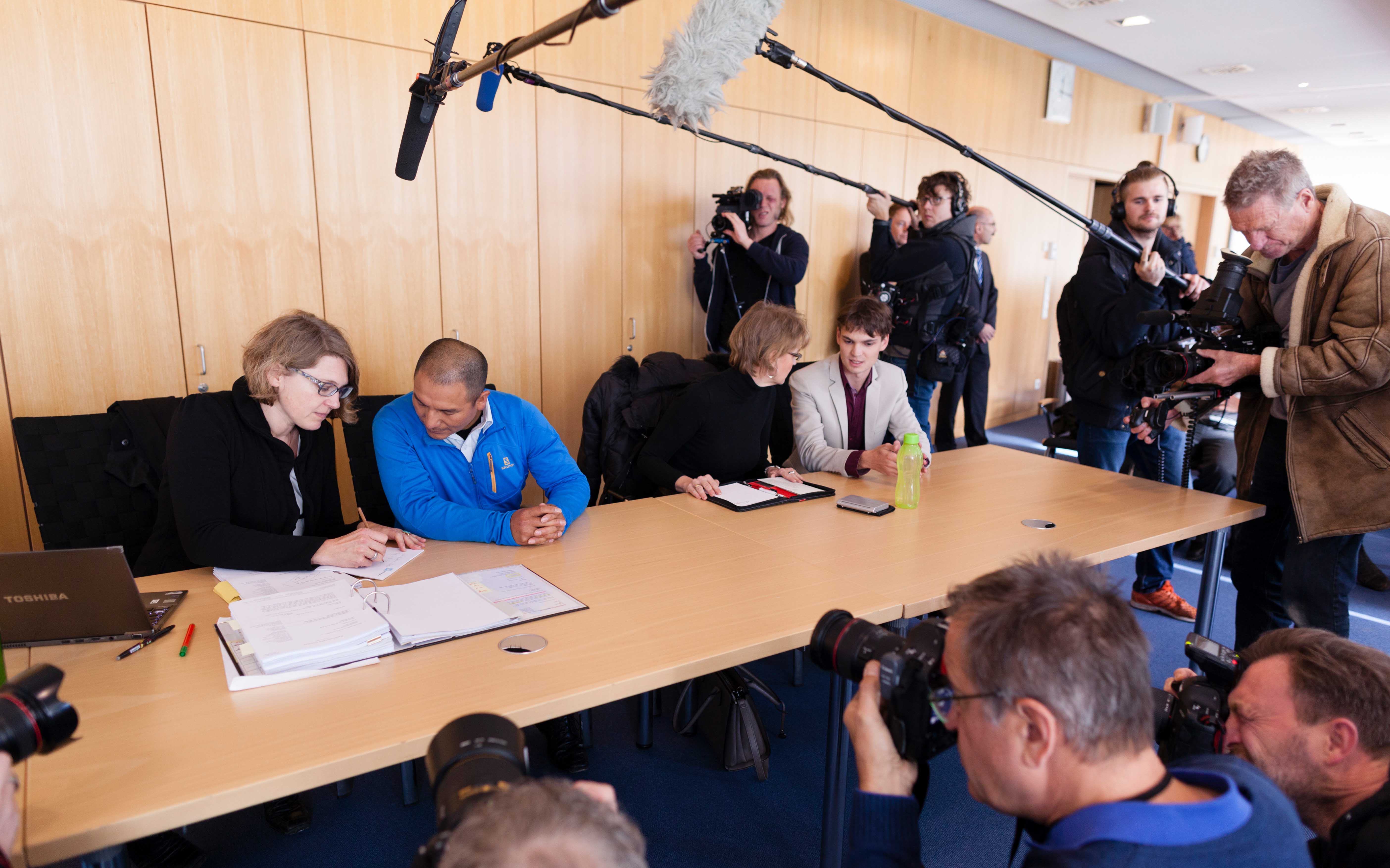What do Shell, the European Union and the Queen of the United Kingdom have in common?
All of them are defendants in climate change lawsuits. Claimants in these suits take on great opponents. Journalistic pieces on the topic often compare them to biblical David taking on the great Goliaths of our modern era: Governments, Ministries, Big Oil. These bold steps might be in reaction to an accelerating climate crisis and inadequate international response.
While new records in disaster-related damages continue to make the news and shake lives, scientists are getting better at establishing links between climate change and extreme weather events such as increasingly intense heat waves and hurricane seasons. This has led to a growing interest in the role of law in dealing with climate related harm. Scientific findings are a requirement for being able to sue. In court, the principle applies that each party must prove the facts that are favorable to it. If science can prove that human-induced climate change has contributed to the emergence of extreme weather events or other adverse climate impacts, it will be possible to bring actions before the courts. These lawsuits could aim at establishing responsibility for incurred damages, or at preventing future damages.
What is climate change litigation?
Climate change litigation, often shortened to ‘climate litigation’, is a way of trying to either advance or delay climate change action by bringing a conflict of interest in front of a court.
As an example, a lawsuit to advance climate action could be presented by a group of citizens that feels threatened by the effects of climate change, and finds its government’s efforts to prevent climate change insufficient, so they sue the government to require it to do more. This was the case, for example, in Urgenda Foundation v. State of the Netherlands. This lawsuit was brought by a Dutch environmental group and 900 Dutch citizens in order to require the Dutch government to do more to prevent climate change. As a result, the Court ordered the Dutch state to reduce greenhouse gas emissions by at least 25% below 1990 levels by the end of 2020 because it found the government’s existing pledge insufficient to meet the state’s fair contribution toward the 2°C goal enshrined in the Paris Agreement.
On the other hand, there are also climate lawsuits that aim at hindering climate action. An example of this would be a corporation that sees its business model e.g. in the coal, oil, gas, cement or automobile sector threatened through new climate change regulations and then sues the government to relax the regulations.
As of September 2020, the often-cited Climate Change Litigation Database maintained by the Sabin Center for Climate Change Law counts 1256 climate cases (both advancing and hindering climate action) within the U.S. and 381 cases throughout the rest of the world (37 countries, the EU, and several supranational jurisdictions1). There are more than ten recorded climate cases in Australia (107), the UK (59), the EU (55), Canada (25), New Zealand (18), Spain (13) and France (11).
Of the cases from the database that have already been decided, 58 per cent (187) of those brought outside the U.S. have led to more effective climate regulation while 33 per cent (106) led to an outcome that undermined climate regulation or was likely to result in greater greenhouse gas emissions (Setzer and Byrnes 2019)2. Analysis of 534 cases brought in the U.S. between 1990 and 2016 found that 42 per cent led to more effective climate regulation (Eskander, Fankhauser, and Setzer 2020).
This article will focus on climate litigation as a way of advancing climate change action. Pro-climate claims are filed by a growing number of organizations, citizens, cities, municipalities or federal states. In the vast majority of lawsuits, they want to press national governments to be more ambitious on climate or to enforce existing legislation. In addition, climate lawsuits against corporations for liability and compensation of climate harms are also becoming more common. In these cases, claimants seek funding for necessary adaptation measures or compensation for climate induced damages e.g. to infrastructure. Defendants are major emitters, such as the automobile, cement, oil or gas industries, like Exxon Mobil, BP and RWE. An example that has gained substantial international attention is Luciano Lliuya v. RWE AG: the Peruvian small-scale farmer and mountain guide Saúl Luciano Lliuya who wants the energy giant RWE to cover part of the expenses for appropriate safety precautions at a glacial lake above his hometown. The lake has grown in size due to climate-induced glacial retreat and threatens to overflow or even break its dam. Luciano requested the court to determine that RWE is liable, proportionate to its GHG emissions, for paying part of the cost of a much bigger dam and/or a pumping system.
How does science come into play?
A must for winning a pro-climate lawsuit is that the court agrees with the claimant on the basics of climate science i.e that the climate is warming due to human activity and that this leads to a variety of adverse impacts. A recent exhaustive report (Banda 2020) on the topic finds that judges and litigants do not question the causes, extent, urgency, and consequences of climate change. This is a major shift from the recent past, when climate skepticism was still commonplace among judges and litigants. Climate science has played a major role in this development by providing a wealth of evidence that contradicts the arguments brought forward by climate skeptics.
The second way in which climate science is crucial in court cases is that it provides empirical evidence which can be used both as part of the complaint (the first document submitted by the claimant to the court detailing his or her arguments) and as proof during the taking of evidence.
Further down, this article will use some relevant examples of climate lawsuits in order to show how claimants used science in their arguments.
What are admissibility challenges for pro-climate lawsuits?
Consensus on climate science is, however, not the only factor in the success of a pro-climate lawsuit. Both science-related and legal factors influence the success or failure of climate suits.
On the legal side, a court must consider whether it is in its competence to hear a case before a claimant can proceed to argue the case. This is referred to as ‘admissibility’. Some general admissibility criteria that often prevent climate suits from proceeding include:
- standing i.e. the right to bring a case before a court. A claimant must be able to show that some personal legal interest has been invaded by the defendant. In some countries, the law might require a claimant to show that the impacts of climate change have affected (or will affect) her or him in a way which differentiates from other persons in the same country. For example, a person living in an area particularly affected by forest fires or droughts which can be linked to climate change could argue to be directly affected by the government’s inadequate climate policies;
- the political question doctrine (also called ‘justiciability’). In order to maintain separation of powers, the court system has to decide if there is a legal question. It is often argued that courts do not have authority to hear climate cases because such cases raise political questions, and that should be left to the legislative and executive arms of government.
If a court decides that the questions at hand presented by the claimant are political ones, it will reject the case without considering the arguments. This means that scientific evidence won’t even be examined. Standing and the question of separation of powers are some of the most common reasons for a climate lawsuit to be dismissed.
Further down, this article will use some relevant examples of pro-climate lawsuits in order to show which legal or science-related factors might influence the success or failure of climate suits.
Why are the numbers of pro-climate cases on the rise?
Pro-climate litigation has been growing in importance over the past three decades, especially since the mid-2000s. One important reason for this are the worsening adverse impacts of climate change affecting an increasing number of people. For example, heatwaves in Europe, North America and Japan show that high-income countries are feeling climate impacts more clearly than ever before (Eckstein et al. 2019) and recent studies found that the chances of major tropical storms forming increased globally by 6 percent in each of the last four decades (Kossin et al. 2020) and that hurricanes are getting stronger (Emanuel 2020).
Another explanation lies in the slow pace of global climate politics. As of today, only a handful of countries are taking real action to meet the Paris Agreement goal to limit the global temperature increase to well below 2°C, if possible 1.5°C (climateactiontracker.org), even though signatories recognize that “this would significantly reduce the risks and impacts of climate change”3.
The Paris Agreement also provides a new line of legal argumentation for potential climate claims. While there is disagreement as to whether the provisions of the Paris Agreement are binding under International Law, the Agreement provides a global long-term temperature goal and an approach to achieving that goal which claimants can refer to. For instance, the temperature goal and how it relates to global carbon budgets could be used to assess how much a particular project or a corporation’s activity contributes to global GHG emissions, and global warming, respectively, or to judge the adequacy of a government’s proposed emissions reduction actions (Peel, Osofsky, and Foerster 2017).
The recent increase of pro-climate lawsuits also coincides with a heightened interest of NGOs in litigation against governments and major emitters due to their deception with climate politics. NGOs are especially prominent in those cases that make the news internationally.
What are recent examples of pro-climate litigation and what role does science play?
NGOs or individuals v. Governments
Plan B Earth and Others v. Secretary of State for Transport (filed 2018, pending), is a concrete example of a court decision referring to the Paris Agreement. In this case, a UK appeals court ruled in February 2020 that the government had acted unlawfully by approving an expansion of Heathrow International Airport without considering the country’s commitment to meeting the Paris Agreement goals. More specifically, it had failed to consider the non-carbon dioxide climate impacts of aviation and the effects of emissions beyond 2050. The court ordered the Secretary of State for Transport to re-evaluate the project taking into account these important factors (climatecasechart.com). This means that the Secretary will have to base his evaluation on findings from climate science. Two private parties with an interest in the airport expansion appealed to the Supreme Court.
The Heathrow Airport Case is one of the first climate suits in which a court confirmed that governments needed to expressly consider and address the Paris Agreement goals when supporting a project. According to one of the claimants, environmental NGO Plan B Earth, this is setting a precedent with global implications and means that governments can no longer claim to be committed to the Paris Agreement, while taking actions that are inconsistent with it.
Another well-known project-related suit is EarthLife Africa Johannesburg v. Minister of Environmental Affairs and Others (filed 2016, decided). The organization Earthlife Africa Johannesburg sought judicial review of a decision by the Department of Environmental Affairs (DEA) granting an environmental authorization for a coal-fired power plant. The organization held that the DEA had failed to adequately consider climate change-related impacts in this decision. The dispute was centered on whether the government could issue an environmental authorization before knowing the outcome of the climate impact assessment (Banda 2020). The court held the review to be legally invalid because it ignored climate change. It cited South Africa’s commitments under the Paris Agreement as one of the reasons for this decision.
The number of pro-climate cases being filed in low- and middle-income countries is also on the rise. For example, in Leghari v. Federation of Pakistan (filed 2015, decided), a Pakistani farmer Ashgar Leghari famously and successfully sued his own government for failure to carry out the National Climate Change Policy of 2012 and the Framework for Implementation of Climate Change Policy (2014-2030). As a remedy, the court directed several government ministries to each nominate a climate change focal person to help ensure the implementation of the Framework, and to present a list of action points by December 31, 2015. In addition, the court created a Climate Change Commission composed of representatives of key ministries, NGOs, and technical experts to monitor the government’s progress (climatecasechart.com). One judge responsible for the case observed that ‘[c]limate justice is informed by science, responds to science and acknowledges the need for equitable stewardship of the world’s resources’ and that a developing country like Pakistan is ‘predicted to bear the brunt of the effects of global warming’ (Banda 2020).

After the decision at Dutch Supreme Court in the Urgenda Climate Case on 20 December 2019 in The Hague.
FIG 3 / Image source: Chantal-Bekker for Urgenda
Urgenda Foundation v. State of the Netherlands (filed 2015, decided) was brought by a Dutch environmental group, the Urgenda Foundation, and 900 Dutch citizens in order to require the Dutch government to do more to prevent climate change. Claimants and defendant agreed on the need for climate mitigation, but not on the pace, or the level, at which the State needed to start reducing emissions. This necessarily required the court to consider the adequacy of the Dutch response to climate change in relation to the urgency suggested by climate science (Banda 2020). Claimants based their case on official UN and IPCC reports, showing that delayed action on climate change would increase its risks (Banda 2020). They also directly invoked the European Convention on Human Rights (ECHR), more specifically, Article 2, which protects the right to life, and Article 8, which protects the rights to private life, family life, home, and correspondence.
After reviewing scientific evidence, the District Court ordered the Dutch state to limit GHG emissions by an absolute minimum of 25% below 1990 levels by 2020, finding the government’s existing pledge insufficient to meet the state’s fair contribution toward the 2°C goal. The judgment inferred a causal link between the country’s greenhouse gas emissions and present and future climate impacts (Toussaint 2020).
While the government appealed this decision, the Court of Appeal as well as the Netherland’s Supreme Court confirmed it. The Court of Appeal, in contrast to the District Court, recognized Urgenda’s claim under Article 2 and Article 8 of the ECHR, determining that the Dutch government has an obligation under the ECHR to protect these rights from the real threat of climate change. It has been suggested that this could inspire similar rights-based litigation particularly in jurisdictions with similarly framed laws and access to courts (Toussaint 2020).
In the recent past, climate litigation has attracted the general public’s attention and continued to take up speed. An example that has spurred global media response is Sacchi et al. v. Argentina et al. (filed 2019, pending) - a petition filed by Swedish climate activist Greta Thunberg and 15 other children. Petitioners allege that Argentina, Brazil, France, Germany and Turkey violated their rights under the United Nations Convention on the Rights of the Child by making insufficient cuts to greenhouse gases and failing to encourage the world’s biggest emitters to curb carbon pollution. Rights that they refer to include the rights to life, health, and the prioritization of the child’s best interest, as well as the cultural rights of petitioners from indigenous communities. The children ask the United Nations Committee on the Rights of the Child to declare that respondents violated their rights by perpetuating climate change, and to recommend actions for respondents to address climate change mitigation and adaptation. The petition asserts that respondents have the obligations under the Convention 1) to prevent foreseeable domestic and extraterritorial human rights violations resulting from climate change and 2) to apply the precautionary principle to prevent deadly consequences even in the face of uncertainty (climatecasechart.com). Climate science plays a crucial role here because it makes the foreseeability of climate change related consequences and harms possible in the first place.
Individuals v. Corporations
Native Village of Kivalina v. ExxonMobil Corp. (filed 2008, decided) is the very first lawsuit seeking to establish corporate liability for climate impacts. Native Alaskans requested 24 oil, energy and utility companies to pay for the relocation of their village Kivalina. The claimants held that, as a result of climate change, the Arctic sea ice that protects the Kivalina coast from storms had been diminished and that resulting erosion would require relocation of the residents at a cost of $95-400 million.
The first instance court dismissed Kivalina on the grounds that the question of how best to address climate change was a political question that should not be resolved by courts (political question doctrine, see above). Additionally, the court held that the claimants could not demonstrate that the companies had caused them injury. The Appeals and Supreme Courts affirmed the dismissal. However, missing scientific proof only played a minor role in the dismissal of this case. Had the case proceeded to the taking of evidence, the claimants might have been able to provide sufficient scientific proof, but they never got the chance to do so.
Luciano Lliuya v. RWE AG (filed 2015, pending) is so far the only climate case in which a court found that a private company could potentially be held liable for climate damages from its emissions (Toussaint 2020), allowing the case to progress to the evidentiary stage in November 2017. With support of the environmental NGO Germanwatch, Peruvian small-scale farmer and mountain guide Saúl Luciano Lliuya wants the energy giant RWE to assume its share of responsibility for the adverse climate impacts that it has partially caused. Due to climate-induced glacial retreat, a glacial lake above his hometown, the Andean city of Huaraz, has grown in size and threatens to overflow or even break its dam. The plaintiff’s property along with large parts of the city are at risk of a devastating flood that would affect around 50,000 people. Saúl Luciano requests the court to determine that RWE is liable, proportionate to its GHG emissions, to cover the expenses for appropriate safety precautions. This could mean, for example, paying part of the cost of a much bigger dam and/or a pumping system.
Saúl Luciano’s claim is based on the general nuisance provision under German civil law (§1004 BGB). Nuisance is a very old and widely used concept under both civil and common law4. It presumes that persons in possession of property are entitled to its quiet enjoyment. If a neighbor interferes with that quiet enjoyment, either by creating smells, sounds, pollution or any other hazard that extends past the boundaries of the property, the affected party may make a claim in nuisance. Saúl Luciano wants to create a precedent that can be replicated by many other claimants. He chose to rely on a provision that exists in many other legal spaces (jurisdictions) so that his suit would be replicable in many other countries.
In a historic success, the appeals court in Hamm recognized the claim as well-pled and admissible, giving a clear statement that large emitters like RWE are liable for supporting people affected by the adverse impacts of climate change. This means that the case has already set a precedent in legal terms: the court has accepted the claimant’s legal argumentation as valid, its decision establishing a solid argument for legal causality in cases that were not accepted before. What is left to be done now is to provide proof of the factual argumentation of this particular case. This is being done during the evidentiary phase where attribution science will play a decisive role.
While the facts of the case must still be adjudicated, the court’s recognition that a private company could potentially be held liable for the climate change related damages of its greenhouse gas emissions marks a significant development in law (climatecasechart.com).
Cities v. corporations
In City of Oakland v. BP p.l.c. (2017, pending), U.S. District Court Judge William Alsup expressly ‘accept[ed] the science behind global warming’ (Banda 2020). Oakland and San Francisco had sued five oil and gas companies alleging that the carbon emissions from their fossil fuel production had created an unlawful public nuisance. The complaint alleged that both cities were already experiencing impacts from accelerated sea level rise due to climate change. The cities asked the court to require the companies to abate the nuisance by funding a climate adaptation program to build sea walls and other infrastructure necessary to protect public and private property from sea level rise and other climate impacts. The court used several different tools to review climate science and made a number of findings of fact on the matter (Banda 2020). Judge Alsup ultimately granted the defendants’ motion to dismiss in June 2018, finding that issues of global magnitude like climate change are best decided by the political branches, not the courts (political question doctrine, see above). Claimants have appealed this decision.

Oakland City Attorney Barbara J. Parker announces lawsuits on behalf of their respective cities on Sept. 20, 2017 at San Fransico Bay.
FIG 5 / Image source: San Francisco Government Television
City of New York v. BP p.l.c. (2018, pending) is a similar case. New York City filed a federal lawsuit against the five largest investor-owned fossil fuel producers seeking costs the City had incurred and would continue to incur to protect itself and its residents from the impacts of climate change (climatecasechart.com). U.S. District Judge Keenan dismissed the lawsuit noting that the claims required a uniform standard of decision and could not proceed further in federal court. He also concluded that ‘Climate change is a fact of life, as is not contested by Defendants. But the serious problems caused thereby are not for the judiciary to ameliorate. Global warming and solutions thereto must be addressed by the two other branches of government’ (Banda 2020). New York City appealed this decision.
Conclusions
As the examples above demonstrate, there is no silver litigation bullet for climate change (Brooke 2019). Lawyers in climate litigation cases are breaking new legal ground and have to consider the respective national or regional legal cultures. What is likely to succeed varies across legal spaces (jurisdictions). Suits such as the Heathrow Airport case seem to have good prospects for success. And so do lawsuits like Urgenda that aim to increase a government’s climate mitigation ambition without seeking to prescribe in detail how this is to be done, thereby maintaining the separation of powers.
Climate claims that seek to establish liability may prove most successful when based on impacts that can be attributed to anthropogenic climate change with high confidence, such as sea level rise, melting snowpack, increases in average temperatures and extreme heat, and ocean acidification (Burger, Wentz, and Horton 2020). However, climate science is rapidly evolving, and the area of scientific uncertainty is shrinking (Banda 2020) so that other types of liability cases might become possible soon. So far, Luciano Lliuya v. RWE AG is the only liability claim that has even made it to the evidentiary phase. Therefore, assumptions about what kind of prove from climate science courts would or would not accept are mostly speculative.
To date, most climate suits have not failed due to any limitations in the science, but because of procedural obstacles including standing and the political question doctrine. While existing legal systems may not be adequately equipped in their present form to respond to such claims, they will be challenged to evolve over time to respond more effectively (Doelle and Seck 2020). Pro-climate lawsuits contribute to the development of the law and reveal gaps in protection, thereby accelerating the necessary adjustment of legal systems (Burger and Gundlach 2019).
Irrespective of the success of pro-climate cases, their global symbolic effect should not be underestimated (Burger and Gundlach 2019). They involve a strong narrative that helps people understand the global impacts of climate change. The plight of an individual facing disaster and taking matters into his own hands, such as Saúl Luciano Lliuya from Peru is doing, is a story that is more accessible for many people than abstract reports on temperature rise and climatic processes.
References
Inter-American Commission on Human Rights, International Court of Justice, United Nations Framework Convention on Climate Change, United Nations Special Rapporteurs, European Committee on Social Rights, Inter-American Court of Human Rights, United Nations Committee on the Rights of the Child, United Nations Human Rights Committee.↩︎
The analysis reviewed whether climate law and/or policies were amended after a judgment to include more stringent requirements to respond to climate change, or if climate change obligations were weakened. The analysis includes cases in which the plaintiff was seeking an outcome that would have an adverse impact on climate mitigation or adaptation efforts but did not succeed (Setzer and Byrnes 2019).↩︎
Paris Agreement article 2 1.a): “Holding the increase in the global average temperature to well below 2°C above pre-industrial levels and pursuing efforts to limit the temperature increase to 1.5°C above pre-industrial levels, recognizing that this would significantly reduce the risks and impacts of climate change.”↩︎
Legal systems around the world vary greatly, but they usually follow civil law or common law. In common law, past legal precedents or judicial rulings are used to decide cases at hand. Under civil law, codified statutes and ordinances rule the land. Some countries like South Africa use a combination of civil and common law. Source: https://www.diffen.com/difference/Civil_Law_vs_Common_Law↩︎
Cover image: Saúl Luciano Lliuya at the entrance of the Cojup River valley that emerges from Lake Palcacocha. (Image source: Alexander Luna / Germanwatch e.V.)
Affiliations
1 Germanwatch e.V., Bonn, Germany


